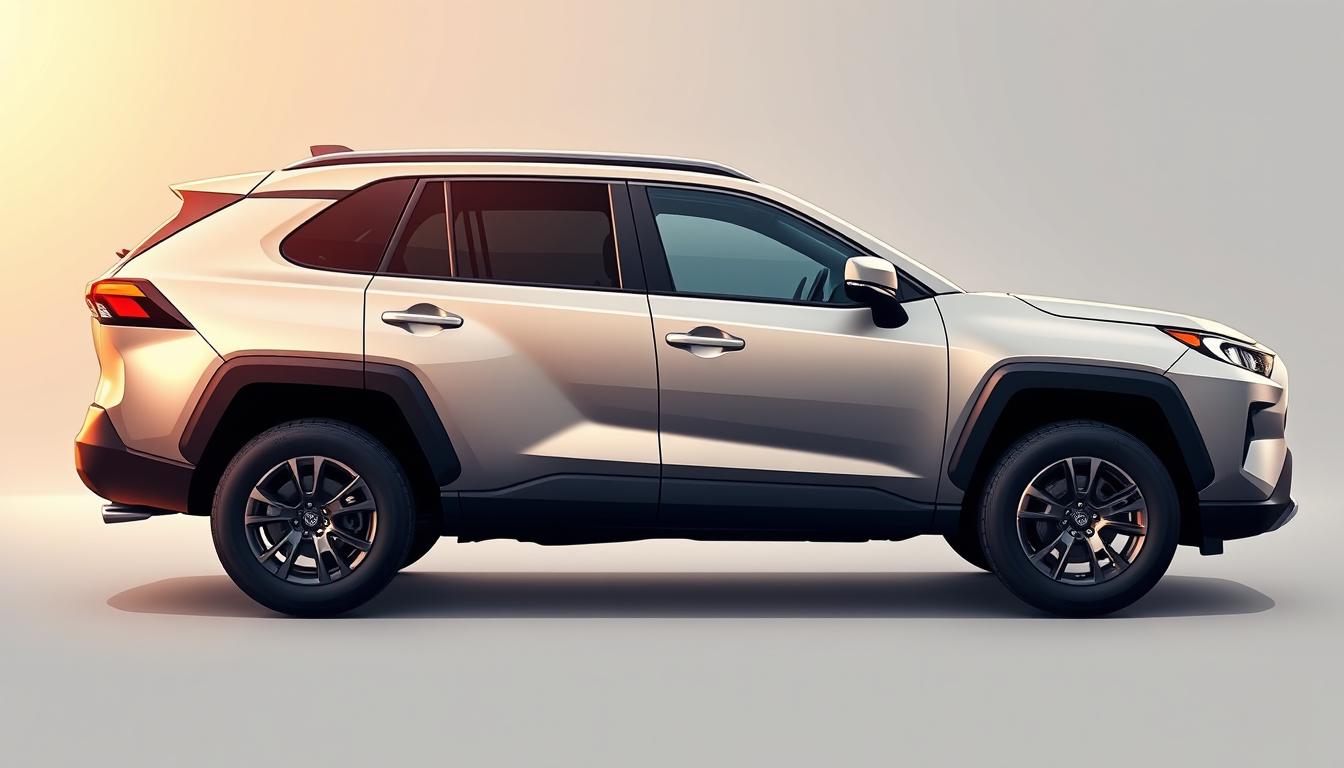When shopping for a compact SUV, space matters. The Toyota RAV4 has earned its reputation as a versatile choice, balancing everyday practicality with modern design. This guide dives into its exterior and interior dimensions, giving you a clear picture of what to expect from this popular model.
The 2025 Toyota RAV4 introduces subtle updates while maintaining the rugged appeal drivers love. Whether you’re curious about cargo capacity, passenger room, or overall footprint, we’ll break down the numbers. From bumper to bumper, every inch counts in this SUV.
Inside, the cabin offers smart layouts for both people and gear. Headroom, legroom, and storage solutions are designed for comfort and convenience. Outside, the vehicle’s height, width, and wheelbase contribute to its confident stance on the road.
We’ll also compare newer models with older versions to highlight improvements. By the end, you’ll know exactly how this compact SUV measures up—literally. Let’s get started!
Overview of the Toyota RAV4 Design and Build
Modern aesthetics meet rugged functionality in this SUV’s latest iteration. Its exterior blends sharp angles with smooth curves, creating a bold yet approachable look. A redesigned grille and LED lighting add contemporary flair, while reinforced body panels emphasize durability.
Exterior Styling and Ground Clearance
Adventure-ready details set this model apart. Roof rails and skid plates hint at off-road capability, complemented by a ground clearance of over eight inches. This height ensures confident handling on rough terrain or city potholes. Sleek roof spoilers reduce wind noise, enhancing highway comfort.
Key Measurements: Length, Width, and Height
The SUV’s footprint balances agility and presence. At 180.9 inches long and 73 inches wide, it navigates tight parking spots without feeling cramped. Its 67.2-inch height provides ample headroom while maintaining a low center of gravity for stability.
Compared to earlier versions, the current features a wider wheelbase for smoother cornering. Every inch of its design serves a purpose—from the tapered rear improving aerodynamics to the squared-off fenders boosting cargo space. These thoughtful touches make it equally suited for grocery runs or weekend trails.
How Big is a Toyota RAV4? Dimensions Breakdown
Understanding a vehicle’s measurements ensures it fits your lifestyle. This compact SUV delivers smart space management, blending passenger comfort with storage flexibility. Let’s explore the numbers that define its usability.
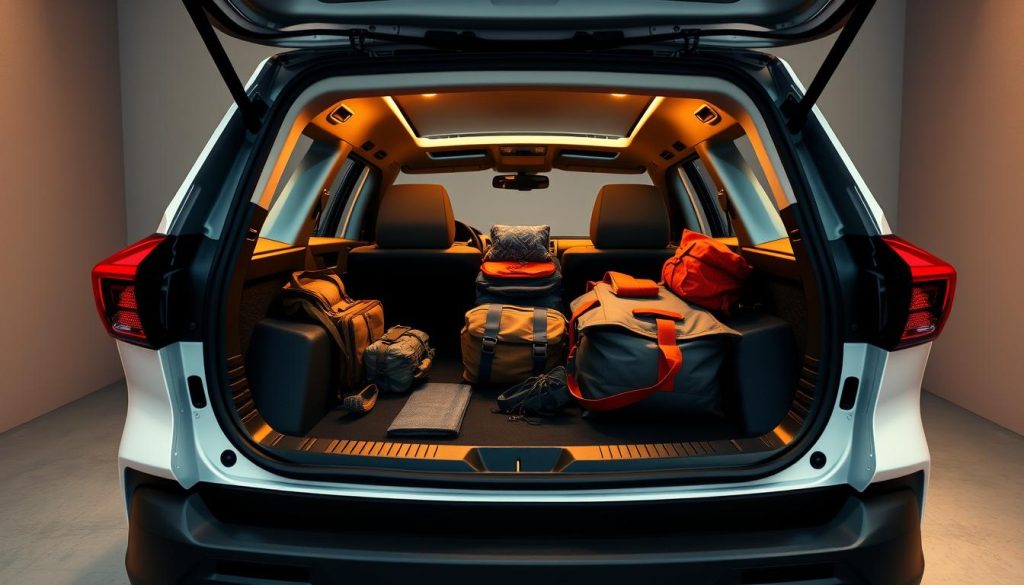
Exact Interior and Exterior Measurements
Front passengers enjoy 41 inches of legroom, while the rear offers 37.8 inches—enough for adults to stretch comfortably. Shoulder room spans 57.8 inches up front and 56.4 inches in back, creating a social cabin layout.
The cargo area provides 37.6 cubic feet behind the second row. Fold the 60/40 split seating, and capacity jumps to 69.8 cubic feet. That’s room for six large suitcases or camping gear.
| Model Year | Length (in) | Cargo Capacity (cu ft) | Rear Legroom (in) |
|---|---|---|---|
| 2025 | 180.9 | 37.6 | 37.8 |
| 2020 | 180.9 | 37.6 | 37.8 |
| 2018 | 176.6 | 38.4 | 37.2 |
Why do these specs matter? The interior width allows three child seats across the back, while the 66.3-inch height prevents head bumps. Exterior dimensions (73 inches wide, 67.2 inches tall) make garage parking stress-free.
Capacity metrics reveal real-world utility. That 69.8 cubic feet rivals many midsize SUVs, perfect for moving day or road trips. Clever details like underfloor storage maximize every inch.
Exploring Interior Space and Technology Features
Step inside, and you’ll find a cabin designed for both relaxation and adventure. Soft-touch materials and intuitive controls create a welcoming atmosphere, while clever storage pockets keep essentials within reach. Let’s explore how this interior balances comfort with cutting-edge tech.
Cabin Comfort and Seating Layout
The driver seat offers 10-way power adjustments, including lumbar support for long journeys. Front passengers enjoy 41.0 inches of legroom, while heated surfaces add warmth during winter drives. Rear seats recline slightly, making every ride feel like first class.
| Feature | Front Row | Rear Row |
|---|---|---|
| Headroom (in) | 39.5 | 39.5 |
| Shoulder Room (in) | 57.8 | 56.4 |
| Hip Room (in) | 54.3 | 47.7 |
Three adults can sit comfortably in back thanks to a flat floor design. Premium fabric or available leather-trimmed seats elevate the ambiance, blending durability with style. Wide door openings make entry easy for all passengers.
Multimedia, Connectivity, and Driver Assistance Systems
A standard 8-inch touchscreen sits at the center of the dash, placing navigation and audio controls in the driver’s line of sight. Upgrade to the 10.5-inch display for crisp graphics and split-screen functionality. Wireless Apple CarPlay® and Android Auto™ keep phones charged and connected.
Advanced systems like adaptive cruise control and lane tracing assist reduce fatigue on highways. The panoramic view monitor acts as a co-pilot, displaying blind spots during tight parking maneuvers. With six USB-C ports and a Wi-Fi hotspot, passengers stay entertained on every adventure.
Cargo Capacity and Flexibility Options
Versatility is key when it comes to maximizing your vehicle’s utility. The RAV4 delivers a cargo capacity that adapts to everything from soccer practice gear to weekend camping supplies. Clever design ensures every inch of space works harder for your lifestyle.
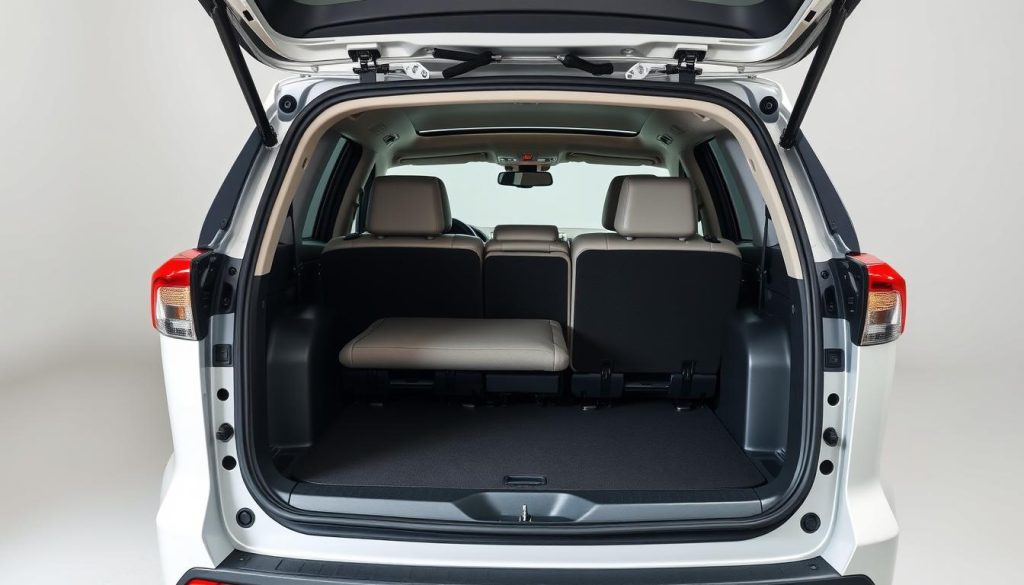
Standard and Maximum Cargo Volume
Behind the second row, you’ll find 37.6 cubic feet of storage—enough for six grocery bags or a stroller. Fold the 60/40 split seats flat, and capacity expands to 69.8 cubic feet. That’s room for two bicycles or a stack of moving boxes.
Flexibility shines with features like adjustable floor panels and underfloor compartments. These options let you organize tools, emergency kits, or fragile items securely. Dual-level storage keeps smaller items from rolling around during drives.
For road trips, the spacious rear accommodates coolers and luggage without sacrificing passenger legroom. Even with seats upright, the wide liftgate opening makes loading bulky items effortless. Compared to similar vehicles, this model offers 15% more usable depth behind the rear axle.
Efficient packaging doesn’t compromise fuel economy. The aerodynamic shape and lightweight materials help maintain competitive MPG ratings. Whether you prioritize cargo space or efficiency, this SUV gives you the choice to tailor it to your needs.
Comparing Model Years and Trim Options
Choosing the right SUV involves balancing past innovations with present upgrades. Over the years, subtle design tweaks and trim enhancements have refined this model’s capabilities. Let’s explore how dimensions and features evolved across generations—and what that means for your driving experience.
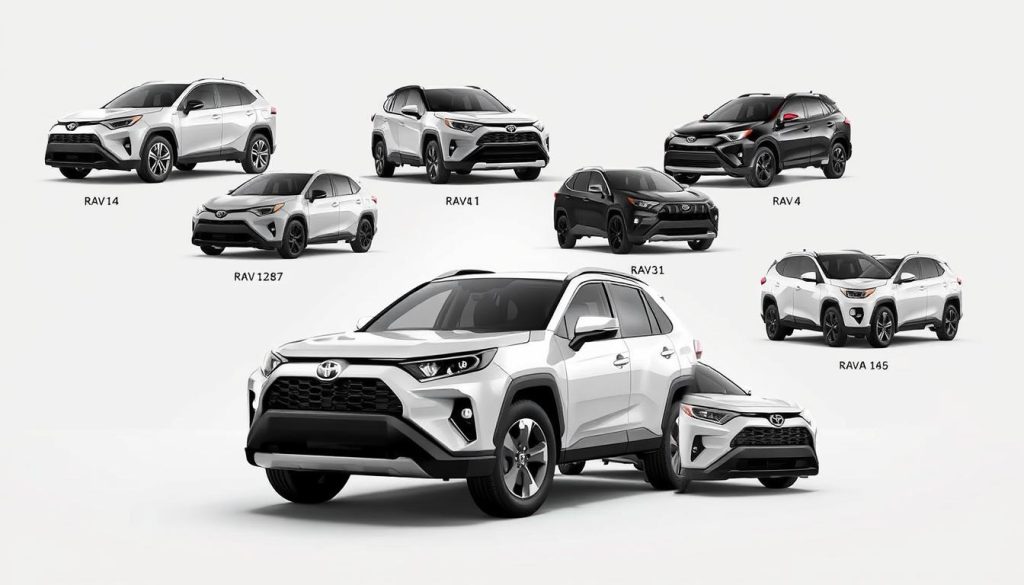
Differences in Dimensions from Previous Models
The 2013 version measured 179.9 inches long—nearly identical to today’s model. However, its wheelbase grew by 1.2 inches in 2016, improving cabin space. By 2019, ground clearance increased to 8.4 inches for better off-road performance.
| Model Year | Length (in) | Wheelbase (in) | Ground Clearance (in) |
|---|---|---|---|
| 2013 | 179.9 | 104.7 | 7.5 |
| 2016 | 176.6 | 104.7 | 7.9 |
| 2025 | 180.9 | 105.9 | 8.4 |
These changes reflect a focus on versatility. The latest models prioritize passenger comfort without sacrificing rugged capability.
Trim-Specific Interior and Feature Variations
Base trims like the LE offer cloth seats and a 7-inch display. Upgrading to the XLE adds dual-zone climate control and power-adjustable seats. Adventure and Limited trims include terrain-select drive modes for enhanced traction.
Hybrid options debuted in 2016, pairing electric power with gas efficiency. Today’s plug-in variants deliver 42 miles of electric-only range. Upper trims also feature panoramic sunroofs and heated steering wheels—perfect for chilly mornings.
Whether you prioritize affordability or premium perks, there’s a trim that fits your lifestyle. Test driving multiple configurations helps pinpoint the ideal balance of power and practicality.
Safety Features and Driver-Assistance Technologies
Peace of mind comes standard with this SUV’s advanced protective systems. Every drive benefits from seamless integration of sensors and software designed to anticipate risks before they escalate. Let’s explore how these innovations work together to keep you and your passengers secure.

Active Safety Systems Overview
The Toyota Safety Sense™ suite acts as a digital co-pilot. Lane departure alerts gently nudge the steering wheel if drifting occurs, while dynamic radar cruise control maintains safe distances in traffic. Automatic high beams adjust brightness based on surrounding vehicles—no manual toggling required.
These systems don’t just watch the road—they monitor the powertrain and engine performance too. If stability sensors detect slippery conditions, power distribution adjusts instantly to prevent wheel spin. This coordination between safety tech and mechanical components creates a responsive center of control.
What sets this model apart from other SUVs? Its pre-collision system detects pedestrians and cyclists, day or night. Road sign recognition projects speed limits onto the dashboard, reducing distractions. Even the style remains sleek, with cameras and radar hidden within the grille and mirrors.
Efficiency meets protection through smart engineering. The hybrid powertrain’s regenerative braking works with stability control to optimize energy recovery during sudden stops. This synergy ensures safety upgrades never compromise the engine’s fuel-saving capabilities.
From highway merges to crowded parking lots, these features blend invisibly into your drive. They’re not add-ons—they’re foundational elements of the vehicle’s design. That’s how modern SUVs earn trust mile after mile.
Performance, Drive Modes, and Hybrid Powertrain
From city commutes to weekend adventures, this SUV’s engineering bridges spirited performance with eco-conscious innovation. The 203-horsepower 4-cylinder engine pairs seamlessly with available all-wheel drive, offering confident traction across diverse terrains. Drivers can tailor their experience through three adaptive drive modes—each optimizing the balance between responsiveness and efficiency.
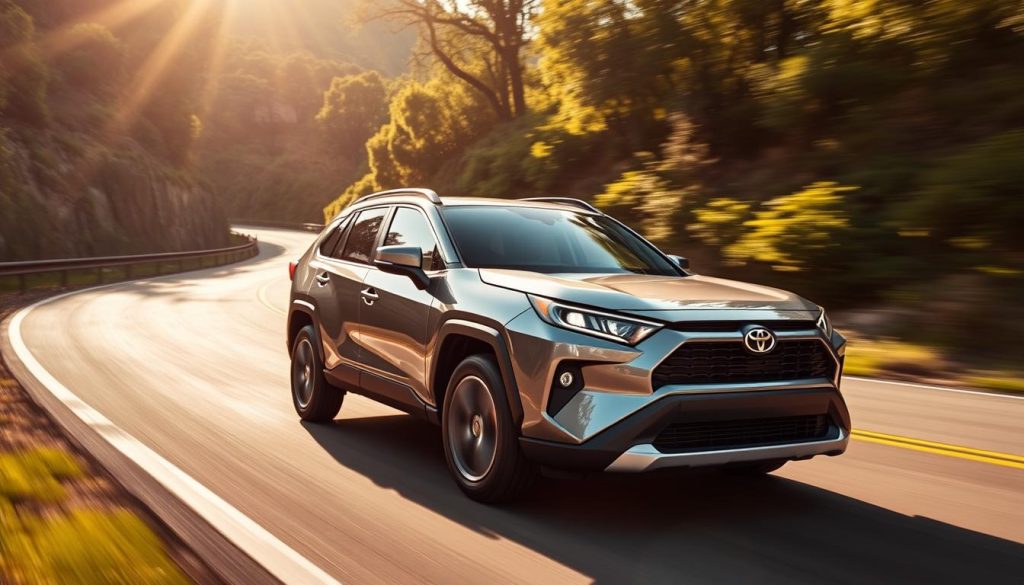
Engine Specifications and Drive Mode Options
The 2.5L 4-cylinder engine delivers smooth acceleration, whether merging onto highways or climbing steep hills. Three settings adapt to your day-to-day needs:
- SPORT: Tightens steering and throttle response for winding roads
- ECO: Prioritizes fuel savings during stop-and-go traffic
- NORMAL: Balances comfort and efficiency for everyday errands
Available AWD automatically redistributes power between wheels, enhancing stability on wet pavement or gravel paths.
Hybrid Powertrain Benefits and Efficiency
Opting for the hybrid powertrain unlocks game-changing advantages. Electric motors supplement the gas engine, boosting torque while reducing emissions. This setup achieves an EPA-estimated 41 MPG combined—perfect for stretching your fuel budget during daily drives.
The hybrid system extends driving range to over 500 miles per tank, minimizing stops on road trips. Unlike traditional hybrids, acceleration remains brisk thanks to instant electric torque. Whether navigating urban streets or open highways, efficiency never comes at the cost of capability.
Conclusion
Balancing practicality with innovation, this compact SUV proves smart design maximizes every inch. With 37.8 inches of rear legroom and seats that adapt to cargo needs, it blends daily comfort with weekend adventure readiness. Clever storage solutions like underfloor compartments and 69.8 cubic feet of expanded space ensure gear stays organized without sacrificing passenger room.
Trim variations cater to diverse lifestyles—whether prioritizing hybrid efficiency or premium tech features. Advanced safety systems and terrain-responsive drive modes complement the spacious interior, creating a vehicle that works as hard as you do. The thoughtful layout accommodates three adults in back while maintaining a garage-friendly exterior footprint.
When evaluating options, consider how its 41 MPG hybrid performance pairs with family-friendly flexibility. The blend of space, room, and adaptive seating makes it ideal for both commutes and cross-country trips. Ready to experience it? Visit your nearest dealership to explore trim choices firsthand and take this versatile SUV for a spin.
FAQ
What is the cargo capacity of the Toyota RAV4?
The standard cargo volume is 37.6 cubic feet behind the rear seats. Folding the rear seats expands storage to 69.8 cubic feet. Hybrid models offer slightly less maximum space due to battery placement.
Does the hybrid powertrain affect interior space?
The hybrid system is seamlessly integrated, preserving passenger and cargo room. Rear legroom remains generous at 37.8 inches, and all trims maintain a spacious cabin layout.
How much ground clearance does the RAV4 Adventure trim have?
The Adventure trim features 8.6 inches of ground clearance, ideal for off-road scenarios. Other trims sit slightly lower at 8.4 inches, balancing stability and urban maneuverability.
Can the RAV4 comfortably seat five adults?
Yes! With 41.0 inches of front legroom and 37.8 inches in the rear, passengers enjoy ample space. The 60/40 split-folding rear seats enhance flexibility for larger items.
What trim levels offer the most interior features?
Higher trims like Limited and Platinum include premium options like ventilated seats, a panoramic sunroof, and softex-trimmed surfaces. All models come standard with Toyota Safety Sense 3.0.
How does the RAV4’s width compare to other compact SUVs?
At 73.4 inches wide (excluding mirrors), it’s slightly broader than rivals like the Honda CR-V, enhancing shoulder room and stability without compromising parking ease.
What fuel efficiency can I expect from the hybrid model?
The hybrid powertrain delivers up to 41 MPG combined, while gas models achieve up to 30 MPG. All-wheel-drive variants see a minor reduction in efficiency.
Are there differences in cargo space between model years?
Recent updates prioritize cabin optimization, but cargo dimensions remain consistent. The 2025 RAV4 introduces new tech features without altering storage capacity.
What driver-assistance features come standard?
Every RAV4 includes adaptive cruise control, lane-keeping assist, and automatic emergency braking. Higher trims add parking sensors and a 360-degree camera system.
Does the RAV4 offer multiple drive modes?
Yes! Select trims include Eco, Normal, Sport, and Trail modes. Hybrid models add an EV mode for short electric-only driving at low speeds.
